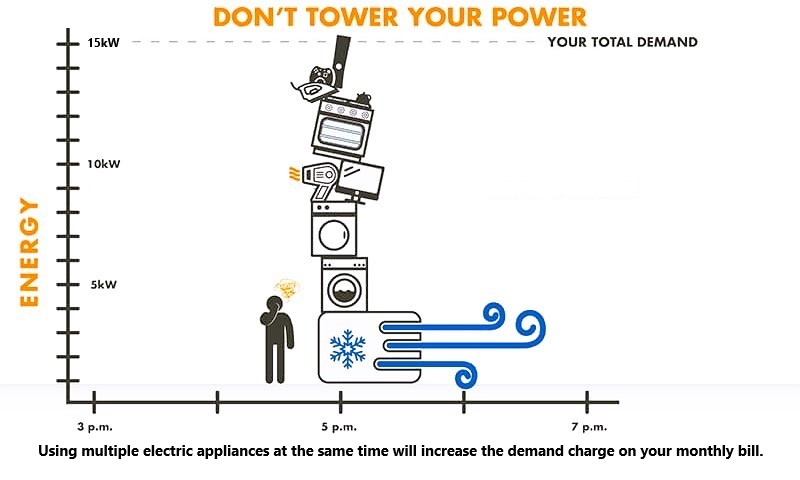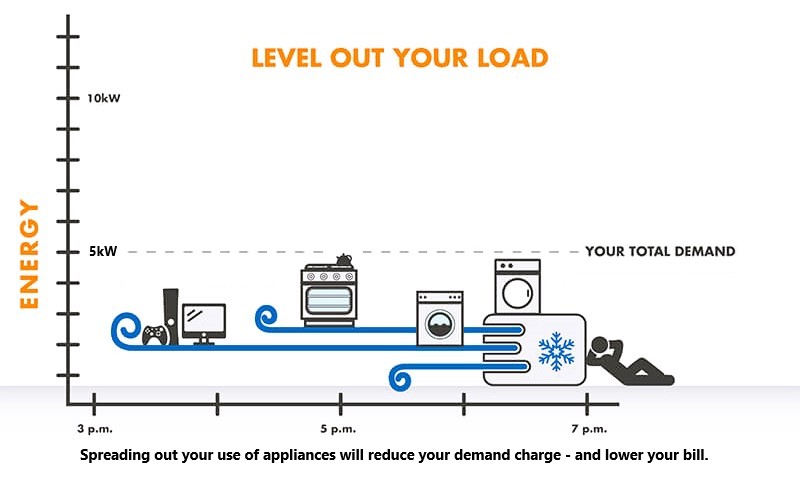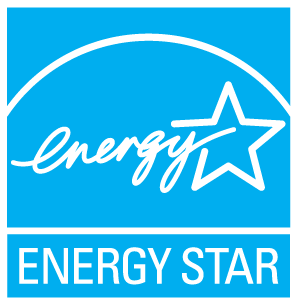What is Demand?
Demand is the amount of power needed to supply every electrical device running in your home or business at a specific point in time. It is the maximum rate at which your household or business has consumed electricity.
Demand on your bill is measured and recorded at the 15-minute interval of your highest rate of power consumption during the billing month. Your high demand value re-sets at the beginning of the next month billing cycle.
Use our bill calculator to see the affect that demand will have on your bill.
Why bill on Demand?
Why are you changing your bills to show demand?
Y-W Electric Association, Inc. (YWEA)breaks out demand from the Energy Usage to be fair and equitable to all YWEA members.
YWEA’s wholesale rates are based on total co-op demand. Some members create more demand by using more appliances at the same time and as a result, a higher demand for electricity.
The industry and many utilities are beginning to see a need to move to a three-part bill, with a demand charge, energy usage charge and a service charge.
In the past, it was easier and cheaper to simply bill metered kWh usage. With Automated Metering Infrastructure (AMI) available today to capture demand, it makes sense to unbundle demand and make sure everyone pays their fair share, removing past subsidies among rate payers.
I can’t help what my demand is. Why am I being billed for demand?
The member demand has always been bundled with the energy and service charges, but now we are able to measure demand and bill separately. Unbundled charges for demand more fairly distributes the costs of providing service to all members.
Equipment to meet members’ electrical demand must be on standby and ready to meet any increased need for electricity immediately. This may ultimately include installing additional transformers, wires, substations and even additional power plants.
How can I find what my demand is?
Members can see their demand on their bill or call into our office and our Billing department can tell you.
How can I reduce demand?


All households that use electricity create a certain level of demand. For some families, it will be a matter of deciding when to use appliances to help manage and reduce demand. For some busy families, saving time will be more important than reducing demand.
The easiest way to reduce demand while meeting household energy consumption requirements is to spread usage throughout the day and night, perhaps using appliance timers.
Members can review household or business processes and determine if it’s possible to perform high energy consuming tasks at different times of the day. Perhaps some appliances or equipment can be used in the morning and other appliances or equipment in the afternoon or evening to balance and reduce demand, with the goal of ultimately reducing peak demand.
Many newer appliances have timers, making it easy to get it ready to go and simply delay the start time. With a little planning, demand billing provides you more control over your electric bill with the ability to manage when you use power, not just how much you use.
For comprehensive information on how to save energy and to reduce demand, we recommend www.energystar.gov.
How do net metering accounts show demand?
Net metering accounts bill normally, showing the demand charge as a separate line item, as with all other co-op members.
What appliances affect my demand?
 Everything with a plug, from a hair dryer to a freezer, affects demand. For general information on appliances, we suggest visiting https://www.energystar.gov/productfinder/?s=mega
Everything with a plug, from a hair dryer to a freezer, affects demand. For general information on appliances, we suggest visiting https://www.energystar.gov/productfinder/?s=mega
There’s a comprehensive list of appliances and information about their efficiency. If you’re shopping for appliances, we recommend looking for the Energy Star label, as it will be among the most efficient.
How much do lights affect my demand?
Very little, because lighting represents less than 15 percent of the average household electric bill, and it’s possible to lower that by using LEDs, and of course, turning off lights when not needed.
To illustrate demand, one 100-Watt light bulb running for 10 hours uses 1 kWh of electricity. Ten 100-Watt light bulbs running for one hour use the same 1 kWh of electricity but require 10 times the generating resources (demand) to produce the same amount of electricity. Light bulbs are a simplified example, but when talking about large appliances in a home such as heating and cooling systems, electric ovens and clothes dryers, we can see how running all of these appliances at once requires significantly more resources than staggering their usage over various times.
